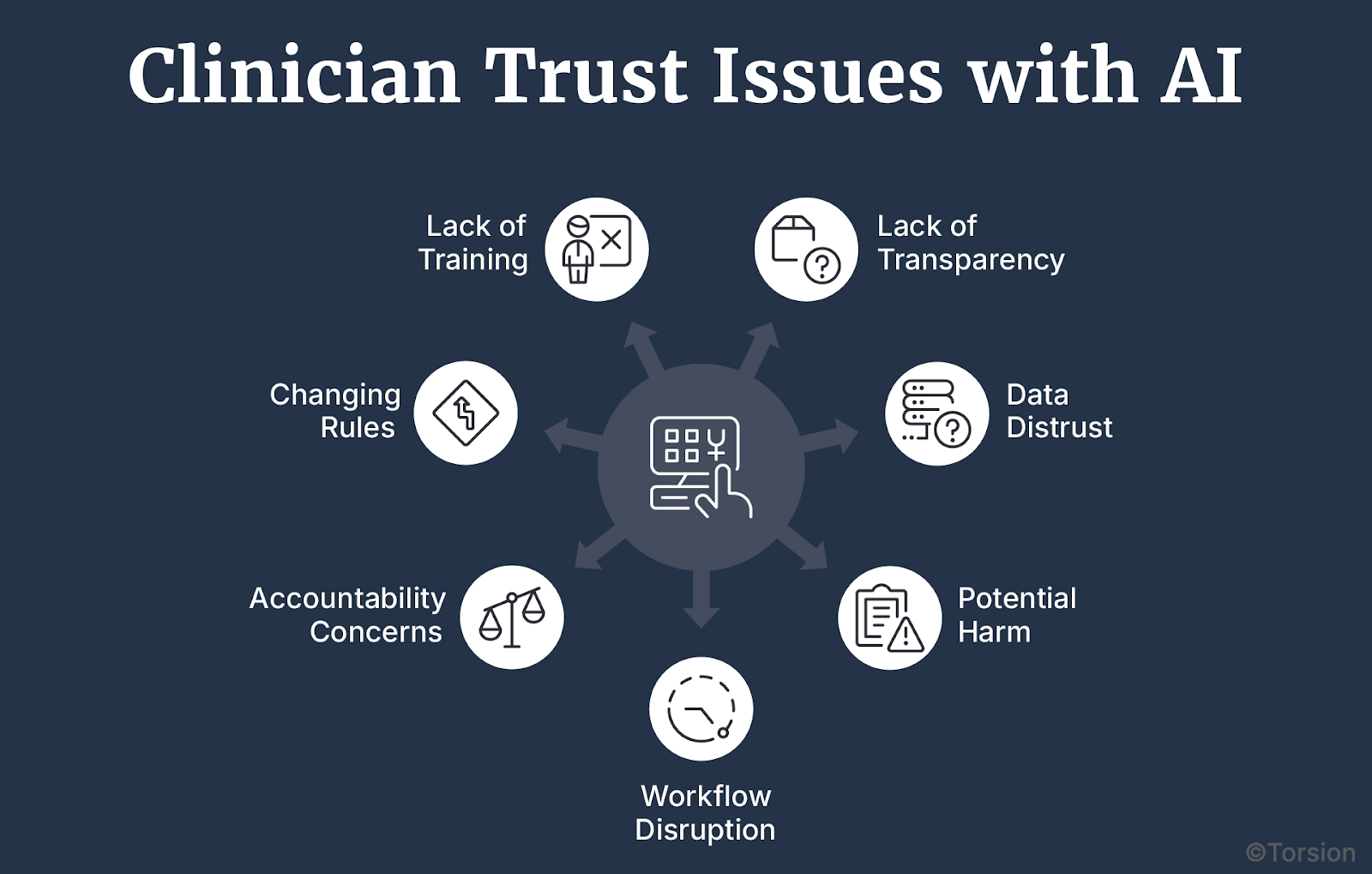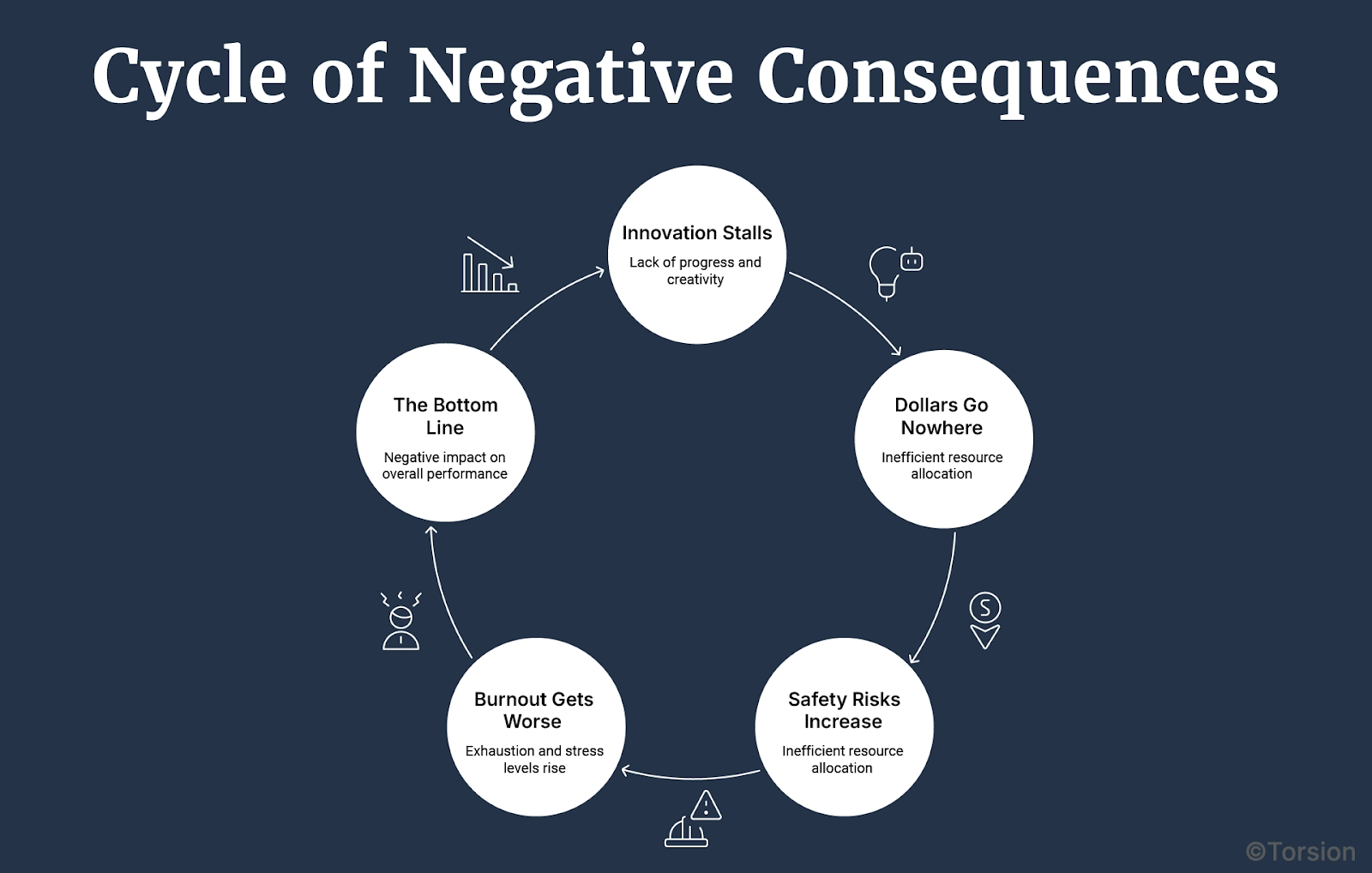Key Takeaways
- 96% of clinicians see potential but trust still lags.
- Only 26% of U.S. providers trust Enterprise AI today.
- Poor explainability and workflow friction are top blockers.
- Most tools fail due to lack of clinical integration.
- Governance, education, and co-design drive real adoption.
Most clinicians aren’t afraid of technology. But they are skeptical, often for good reason.
According to the Philips Future Health Index (2025), more than 34% of clinicians now say they see the benefits of model-driven systems in care delivery. That number is higher than public perception. But optimism isn’t the same as trust.
Especially among seasoned providers, there’s a hesitation that has little to do with fear of change. It’s about what’s missing: context, transparency, and shared control.
When a system makes a recommendation—one that affects care plans, outcomes, or documentation—clinicians want to know:
- Where did this output come from?
- What data was used?
- Can I override it if it’s wrong?
- Who’s responsible if something goes sideways?
What Happens Without Trust

Without clinician confidence, even the best model doesn’t leave the sandbox. It stays locked in proof-of-concept mode, sidelined by users who don’t understand it, or don’t believe it belongs.
And that comes at a cost:
- Wasted spend on tools that never scale
- Slow adoption cycles across departments
- Higher risk when tools are misunderstood or ignored
- Frustration among clinicians who were told these systems would help—but weren’t involved in how they were built
Trust is the gatekeeper. No trust, no adoption. No adoption, no impact.
This is the hard edge where tech either works, or quietly fails.
The Seven Real Reasons Clinicians Don’t Trust Enterprise AI
Trust issues in healthcare aren’t abstract. They’re specific, earned, and usually well-founded. Below are seven core reasons why many clinicians, even those optimistic about model-driven care, still hesitate to use these tools at the bedside.

1. They Can’t See How It Works
If a system makes a decision about a diagnosis, a dosage, or a next step in care, clinicians want to know where that came from. But most models still operate like black boxes. Even tools built to explain their logic (like SHAP or LIME) are often too technical to help in the moment.
Why it matters: Clinicians are legally and ethically responsible for what they act on. If they can’t explain it, they can’t use it.
2. They Don’t Trust the Data
Only 33% of experienced providers say they trust the data used to train clinical Enterprise AI models. That’s not surprising. Most clinicians don’t know what’s in the training set, how it was cleaned, or whether it represents their patient population.
What they worry about:
- Hidden bias in race, gender, or geography
- Outdated or mismatched documentation
- PHI exposure risks and unknown provenance
Bad input means unreliable output. Clinicians know that. They live it.
3. One Wrong Output Can Do Real Harm
When a model makes the wrong call, it’s the clinician, not the developer, who carries the risk. Enterprise AI drift is especially dangerous in fast-moving specialties where protocols evolve quickly.
The risk:
- A model that worked in Q1 may not hold up in Q3
- Without drift monitoring, risk accumulates quietly
- Mistakes made by the system still get blamed on the person using it
And when one error slips through, trust is hard to rebuild.
4. It Gets in the Way of the Work
If a tool slows things down, adds more clicks, or forces context-switching, it won’t get used. Many current tools were built outside the clinical environment, and it shows.
Even human-in-the-loop models, when poorly designed, just become another task.
5. Accountability Is Still Murky
When something goes wrong, who’s responsible? More than 75% of clinicians say it’s unclear who holds liability when model-driven decisions cause harm.
Open questions:
- Can patients opt out of Enterprise AI-assisted care?
- What happens when a nurse or doctor overrides a system recommendation?
- Are these systems supporting human judgment, or quietly replacing it?
Until those answers are clearer, adoption will stall.
6. The Rules Keep Changing
The FDA, CMS, and ONC are still building policy around large language models, adaptive algorithms, and real-time clinical decision support. Many health systems don’t know where the line is, and don’t want to find out the hard way.
Result: Developers hesitate to push new tools. Clinicians hesitate to adopt them.
Nobody wants to rely on a system that may be out of compliance six months later.
7. Most People Don’t Know How to Effectively Use It
According to multiple surveys, 63% of clinicians say they’d be more comfortable using these tools with formal training. Not because they don’t see the potential, but because they don’t yet know how to separate safe signals from suspect ones.
What’s missing:
- Training on model limitations
- Guidance on when to trust vs. when to verify
- Real-world examples, not just technical documentation
It’s hard to trust a tool you weren’t trained to evaluate.
What Happens If We Don’t Fix This
For clinicians trust is the hinge point between pilot projects and lasting impact. When trust is missing, the costs pile up financially, operationally, and ethically.

Innovation Stalls
A model might test well in a controlled environment. But if the people expected to use it don’t trust it, or don’t know how, it doesn’t leave the lab.
- Only 38% of clinicians involved in AI and digital development believe current tools meet real-world needs.
- In the U.S., just 26% of providers say AI is trustworthy in its current form (GE HealthCare, 2024).
- Most tools stall at the PoC stage, never scaled or standardized.
The result? Teams keep testing variations of the same problem without getting closer to a solution.
Dollars Go Nowhere
Hospitals invest heavily in enterprise systems. But when trust isn’t built in from the start, tools go unused.
- Models sit idle in the EHR
- Interfaces are abandoned after rollout
- Workflow integration fails, so adoption flatlines
The cost is sunk time, lost staff trust, and backtracking that slows other initiatives. And of course, wasted licensing.
Safety Risks Increase
When a tool is misunderstood, misused, or bypassed entirely, it introduces new points of failure. Clinicians may ignore prompts. Or worse, they may trust outputs they shouldn’t without context or understanding.
Burnout Gets Worse
The promise of these tools was to make work easier. But when they’re hard to use, hard to trust, or not aligned with workflow, they just become another source of friction.
- 46% of healthcare professionals worry that poor AI integration will actually increase non-clinical burden
- Every extra click, correction, or override adds to the load
- Poor design leads to more rework, not less
Burnout is emotional fatigue, combined with systems pushing too much cognitive overhead onto clinicians who are already at their limit.
The Bottom Line
If trust isn’t addressed head-on, Enterprise AI becomes shelfware.
It doesn’t matter how accurate the model is or how strong the tech stack looks, if clinicians don’t believe it fits their reality, they won’t use it. And when the people at the center of care delivery opt out, the whole system loses.
The Trust Blueprint: How to Build Enterprise AI That Clinicians Will Actually Use
If poor design creates doubt, thoughtful design can rebuild trust.
What clinicians want isn’t perfection. It’s visibility. Input. Accountability. A sense that the tools they’re being asked to use were actually made with them in mind and won’t disappear after the pilot ends.
To move past stalled rollouts and half-adopted features, Enterprise AI needs to be treated like any other clinical system: governed, auditable, and user-validated from day one.
A. Show the “Why”—Not Just the Result
More than 75% of clinicians say they hesitate to use AI when they can’t explain how it works. This isn’t about dumbing things down, but designing for interpretability, and going beyond performance.
- Use models that can be explained at the point of care, not after the fact.
- Show contributing factors. Let clinicians see what tipped the output.
- Don’t bury rationale in developer tools. Build explanations into the interface.
B. Build Governance into the Infrastructure
Trust starts before the first prediction. It begins with data quality, diversity, and lineage, and is preserved through ongoing oversight.
- Embed bias audits into the pipeline.
- Use MLOps to track drift, performance, and fairness over time.
- Encrypt, log, and monitor PHI access at every stage.
As the CHAI “Blueprint for Trustworthy Enterprise AI” puts it: governance should be part of the architecture, and not a separate task.
C. Design With Clinicians, Not Around Them
Clinician input isn’t feedback. It’s infrastructure. The systems that work best are the ones co-developed by people who actually use them.
- EHR-native interfaces only. No extra logins. No new windows.
- Let users override the model. Show them what happens when they do.
- Create real-time feedback loops that let nurses and physicians flag issues, not just IT.
If the tool doesn’t slot into existing workflows, it’s just one more thing to ignore.
D. Show Value in Terms Clinicians Care About
Only 38% of clinicians involved in Enterprise AI development say the tools they see reflect the needs of real-world care. That disconnect is fixable, but only if evaluation shifts from abstract metrics to tangible outcomes.
Don’t lead with AUC or F1 scores. Lead with:
- This tool caught 14 high-risk patients last month you didn’t have time to flag.
- This tool saved you 22 clicks per shift.
- This model helped reduce time-to-medication by 11 minutes.
Prove usefulness, not cleverness.
E. Make Ethics and Policy Part of the Build
Clinicians worry about accountability for a reason. Without policy alignment and ethical clarity, those concerns don’t go away, they just go underground.
- Set up Enterprise AI governance boards that include clinical and DEI leaders.
- Share your ethical framework internally and publicly.
- Build opt-out mechanisms for patients. Bake in override control for staff.
F. Teach the “When,” Not Just the “How”
According to recent findings, 63% of clinicians say they’d feel more confident using Enterprise AI with formal training. The key is giving them the right mental model, not just a user manual.
- Train nurses, physicians, and allied health staff on when to trust vs. when to verify.
- Build simple guides: What this tool does. What it doesn’t. What to do if it’s wrong.
- Treat Enterprise AI literacy like infection control—basic, essential, and non-negotiable.
Clinicians don’t need to code. But they do need to know what’s under the hood and what to watch for when things shift.
Trust Is The Roadmap for Clinicians
What looks like resistance is often just realism.
Clinicians aren’t holding Enterprise AI back because they’re change-averse. They’re asking the right questions about safety, transparency, and ownership because they know what happens when systems fail.
If Trust Fails, Everything Else Stalls
- Only 26% of U.S. providers trust Enterprise AI in its current form
- Just 38% of clinicians involved in Enterprise AI development say it meets real-world needs
- 46% of healthcare professionals worry Enterprise AI will add to burnout, not ease it
These are indicators that design, governance, and integration still aren’t where they need to be.
But Here’s the Good News
Every trust barrier named in this blog has a clear fix:
- Black box fears → Interpretable, real-time explanations
- Data skepticism → Transparent lineage, built-in audits
- Workflow disruption → EHR-native design and clinician-driven rollout
- Unclear accountability → Governance boards, override controls, and opt-outs
- Enterprise AI illiteracy → Targeted training that focuses on the “when,” not just the “how”
The map is already drawn. What’s missing is follow-through.





